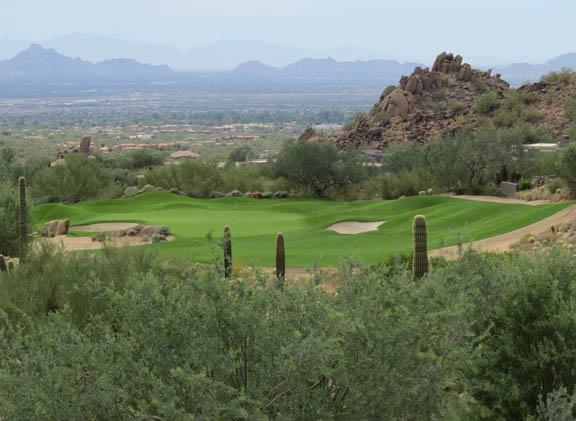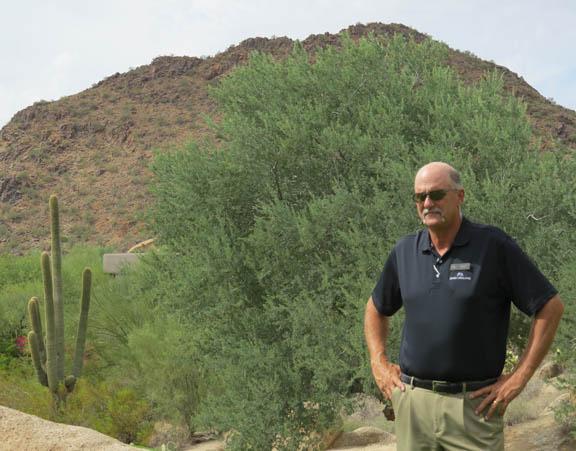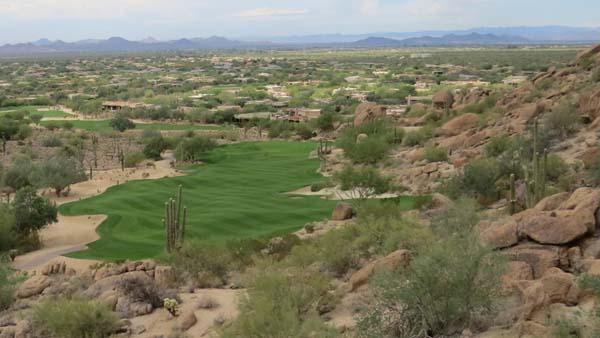It is plainly obvious that members at Desert Highlands love their golf course. In fact, that's what they tell superintendent Phil Shoemaker all day.
 "And I never get tired of hearing it," said Shoemaker, who has been superintendent at the private Scottsdale club - for the second time - since 1999.
"And I never get tired of hearing it," said Shoemaker, who has been superintendent at the private Scottsdale club - for the second time - since 1999.Conditions like those found at Desert Highlands do not just happen. They are the result of years of trial and error, as well as working with academia, local government agencies and other superintendents from throughout Scottsdale.
Although overseeding is pretty much a thing of the past in many parts of the country, it remains a necessity in Scottsdale and likely will for some time to come. And it remains a practice that the success of which is highly dependent on weather.
"Thanksgiving to Easter are our money months," said Shoemaker, who also was superintendent at Desert Highlands from 1982-86. "We've gotta have the ryegrass then.
"Sometimes we hit the weather just right. Sometimes it's a test. This year was a test. Ten days after seeding we had record-high temperatures, then rain for a couple of days, which I'll take, then near-record highs again."
And sometimes, that is easier said than done since so much of the success of overseeding depends on weather.
Shoemaker has redefined conditions at Desert Highlands through a regimen that includes an aggressive fairway topdressing program, helping to lead an effort that resulted in better quality recycled water and eliminating some of the cultural practices associated with overseeding that made the process more challenging.
About a decade ago, Shoemaker began a program that included covering the fairways with heavy amounts of sand. The next five-six years included changing out turf in the fairways, upgrades to the water source and eliminating the aggressive verticutting in advance of overseeding. The reason for the changes were native soils that were so hard they also served as the base for roads in Scottsdale they would barely drain the few times a year in Arizona when it does rain.
In those early days, sand was applied at rates of up to 100 tons per acre that helped raise the profile about 3 inches per year. Today, Shoemaker, who has taken the profile up about 7 inches, continues topdressing 40 acres of fairways two times per year with as much as 800 tons of sand per application.
He also has stopped aggressive verticutting in advance of overseeding, a tip he picked up several years ago at the urging of former Texas A&M professor Milt Engelke, Ph.D.
"Milt bugged me for a couple of years to quit doing all that verticutting and mowing," Sheomaker said. "When you do that, you take out all the Bermuda and there is nothing to come back the next spring. You're taking all the carbs away from the plant.
"The ryegrass is going to grow anyway. This way it might take a little longer, but it's going to fill in."
 When Shoemaker arrived at Desert Highlands, the quality of Scottsdale's recycled water was so poor that keep the course lush and green like members demand was a challenge. About six years ago, Shoemaker and superintendents from the other 20 or so courses in the North Scottsdale Corridor approached the water utility for a solution. The provider agreed to upgrade the treatment plant, at the expense of local golf courses, to include a mix of water that has undergone reverse osmosis, which cut the number of dissolved salts in half. During the summer, when recycled water supplies run short when snowbirds return north, the utility pumps in water from the Colorado River through a system of canals that run to the Phoenix area.
When Shoemaker arrived at Desert Highlands, the quality of Scottsdale's recycled water was so poor that keep the course lush and green like members demand was a challenge. About six years ago, Shoemaker and superintendents from the other 20 or so courses in the North Scottsdale Corridor approached the water utility for a solution. The provider agreed to upgrade the treatment plant, at the expense of local golf courses, to include a mix of water that has undergone reverse osmosis, which cut the number of dissolved salts in half. During the summer, when recycled water supplies run short when snowbirds return north, the utility pumps in water from the Colorado River through a system of canals that run to the Phoenix area."I had to tell members that I needed two years to reclaim that soil after 20 years of pumping bad water on them," he said. "It's not just like flipping a switch. Each year, it started getting better."
Match that cleaner water with a fairway turf mix that includes three Canadian ryegrasses as well as 20 percent Chewings fescue that Shoemaker went to two seasons ago, and transition is a bit easier.
"When the temps hit 90 in the spring, the fescue is going to choke out, and suddenly 20 percent of my grass is gone, and that helps get the Bermuda going," he said.
"Transition here used to be horrible. I mean appallingly horrible. I regrouped on the agronomy program, and now you don't even notice the golf course transition from one grass to another. It's basically green all year.
"For the last four years now, it's actually been fun."


